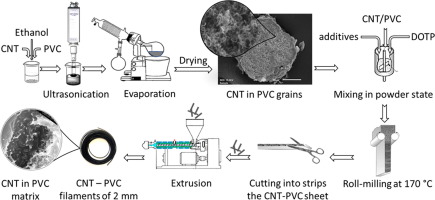当前位置:
X-MOL 学术
›
Arab. J. Chem.
›
论文详情
Our official English website, www.x-mol.net, welcomes your feedback! (Note: you will need to create a separate account there.)
Nanotubes as Polymer Composite Reinforcing Additive Materials – A Comparative Study
Arabian Journal of Chemistry ( IF 6 ) Pub Date : 2020-02-01 , DOI: 10.1016/j.arabjc.2019.01.001 László Vanyorek , Emőke Sikora , Tamás Balogh , Krisztina Román , Kálmán Marossy , Péter Pekker , Tamás J. Szabó , Béla Viskolcz , Béla Fiser
Arabian Journal of Chemistry ( IF 6 ) Pub Date : 2020-02-01 , DOI: 10.1016/j.arabjc.2019.01.001 László Vanyorek , Emőke Sikora , Tamás Balogh , Krisztina Román , Kálmán Marossy , Péter Pekker , Tamás J. Szabó , Béla Viskolcz , Béla Fiser

|
Abstract Nitrogen-doped bamboo-shaped carbon nanotubes (N-BCNTs) and their non-doped conventional counterparts, multiwalled carbon nanotubes (MWCNTs) were compared as polymer reinforcing additives in polyvinyl chloride (PVC) matrix. The nanotubes were synthetized by catalytic chemical vapor deposition (CCVD) method. The purity of both nanotubes was measured by thermogravimetric analysis (TGA) and found to be >91%. Further analysis on the morphology and size of the carbon nanotubes (CNTs) were performed by transmission electron microscopy (TEM). The PVC powder was impregnated with CNTs in ethanol by using tip ultrasonicator. The dispersion media was evaporated, and the CNT/PVC powder was used to produce polymer fibers. The orientation of carbon nanotubes in the PVC matrix was characterized by scanning electron microscopy (SEM), and the presence of nanotubes were confirmed in case of all PVC samples. It can be observed on the SEM images that the nanotubes are fully covered with PVC. The tensile strength of the nanotube containing samples was tested and the N-BCNT/PVC composite was found to be better in this sense, thanks to the extraordinary structure of the nanotube. In case of the N-BCNT/PVC composite the measured young modulus was 39.7% higher, while the elongation at brake decreased by 33.6% compare to the MWCNT/PVC composite. These significant differences in the mechanical properties of the composites can be explained with the stronger interaction between N-BCNTs and PVC.
中文翻译:

纳米管作为聚合物复合增强添加剂材料——一项比较研究
摘要 将掺氮竹形碳纳米管 (N-BCNT) 与其未掺杂的常规对应物多壁碳纳米管 (MWCNT) 作为聚氯乙烯 (PVC) 基体中的聚合物增强添加剂进行了比较。通过催化化学气相沉积(CCVD)方法合成纳米管。通过热重分析 (TGA) 测量两种纳米管的纯度,发现其纯度 >91%。通过透射电子显微镜 (TEM) 对碳纳米管 (CNT) 的形态和尺寸进行了进一步分析。通过使用尖端超声波发生器在乙醇中用 CNTs 浸渍 PVC 粉末。蒸发分散介质,并使用CNT/PVC粉末生产聚合物纤维。通过扫描电子显微镜 (SEM) 表征了 PVC 基体中碳纳米管的取向,并且在所有 PVC 样品的情况下都证实了纳米管的存在。在 SEM 图像上可以观察到纳米管完全被 PVC 覆盖。测试了含纳米管样品的拉伸强度,发现 N-BCNT/PVC 复合材料在这个意义上更好,这要归功于纳米管的非凡结构。在 N-BCNT/PVC 复合材料的情况下,测得的杨氏模量高出 39.7%,而制动伸长率与 MWCNT/PVC 复合材料相比降低了 33.6%。复合材料机械性能的这些显着差异可以用 N-BCNT 和 PVC 之间更强的相互作用来解释。测试了含纳米管样品的拉伸强度,发现 N-BCNT/PVC 复合材料在这个意义上更好,这要归功于纳米管的非凡结构。在 N-BCNT/PVC 复合材料的情况下,测得的杨氏模量高出 39.7%,而制动伸长率与 MWCNT/PVC 复合材料相比降低了 33.6%。复合材料机械性能的这些显着差异可以用 N-BCNT 和 PVC 之间更强的相互作用来解释。测试了含纳米管样品的拉伸强度,发现 N-BCNT/PVC 复合材料在这个意义上更好,这要归功于纳米管的非凡结构。在 N-BCNT/PVC 复合材料的情况下,测得的杨氏模量高出 39.7%,而制动伸长率与 MWCNT/PVC 复合材料相比降低了 33.6%。复合材料机械性能的这些显着差异可以用 N-BCNT 和 PVC 之间更强的相互作用来解释。
更新日期:2020-02-01
中文翻译:

纳米管作为聚合物复合增强添加剂材料——一项比较研究
摘要 将掺氮竹形碳纳米管 (N-BCNT) 与其未掺杂的常规对应物多壁碳纳米管 (MWCNT) 作为聚氯乙烯 (PVC) 基体中的聚合物增强添加剂进行了比较。通过催化化学气相沉积(CCVD)方法合成纳米管。通过热重分析 (TGA) 测量两种纳米管的纯度,发现其纯度 >91%。通过透射电子显微镜 (TEM) 对碳纳米管 (CNT) 的形态和尺寸进行了进一步分析。通过使用尖端超声波发生器在乙醇中用 CNTs 浸渍 PVC 粉末。蒸发分散介质,并使用CNT/PVC粉末生产聚合物纤维。通过扫描电子显微镜 (SEM) 表征了 PVC 基体中碳纳米管的取向,并且在所有 PVC 样品的情况下都证实了纳米管的存在。在 SEM 图像上可以观察到纳米管完全被 PVC 覆盖。测试了含纳米管样品的拉伸强度,发现 N-BCNT/PVC 复合材料在这个意义上更好,这要归功于纳米管的非凡结构。在 N-BCNT/PVC 复合材料的情况下,测得的杨氏模量高出 39.7%,而制动伸长率与 MWCNT/PVC 复合材料相比降低了 33.6%。复合材料机械性能的这些显着差异可以用 N-BCNT 和 PVC 之间更强的相互作用来解释。测试了含纳米管样品的拉伸强度,发现 N-BCNT/PVC 复合材料在这个意义上更好,这要归功于纳米管的非凡结构。在 N-BCNT/PVC 复合材料的情况下,测得的杨氏模量高出 39.7%,而制动伸长率与 MWCNT/PVC 复合材料相比降低了 33.6%。复合材料机械性能的这些显着差异可以用 N-BCNT 和 PVC 之间更强的相互作用来解释。测试了含纳米管样品的拉伸强度,发现 N-BCNT/PVC 复合材料在这个意义上更好,这要归功于纳米管的非凡结构。在 N-BCNT/PVC 复合材料的情况下,测得的杨氏模量高出 39.7%,而制动伸长率与 MWCNT/PVC 复合材料相比降低了 33.6%。复合材料机械性能的这些显着差异可以用 N-BCNT 和 PVC 之间更强的相互作用来解释。



























 京公网安备 11010802027423号
京公网安备 11010802027423号